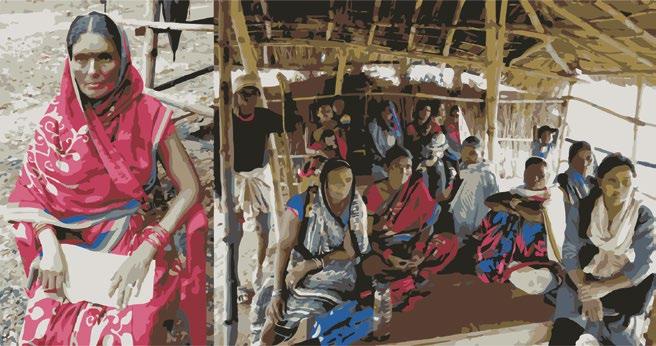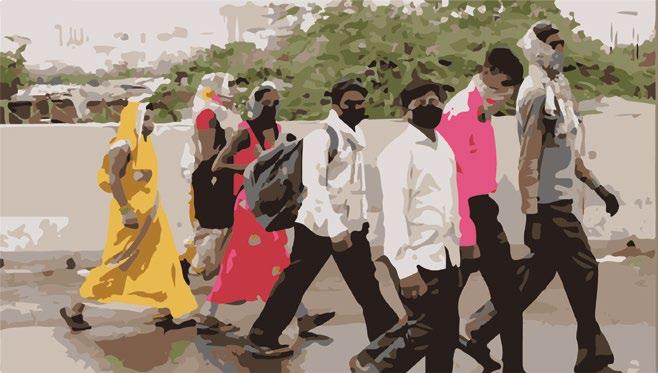
5 minute read
Right to Health
Image: Financial Times
Right to Health: India’s feeble infrastructure
The feebleness of India’s public healthcare infrastructure and lack of access to primary and preventive health systems, became evident in wake of the COVID-19 pandemic and the resulting lockdown. In India, even if the right to health is not expressly mentioned in fundamental rights chapter of the Constitution, it has been considered by the courts to be manifest in the right to life under the all-encompassing and wide scope of Article 21. Health, in India, needs to be understood not only in terms of physiological wellbeing but also in respect of its complex intersectionalities with social and political determinants such as poverty, gender, caste and community disparities, livelihoods, disability and sexuality. According to a report of the Central Bureau of Health Intelligence under the Directorate of Health Services, there has been no significant change in public expenditure on health in the past decade. In 2009-10, public health expenditure was 1.12% of GDP and it has more or less remained the same and in 2017-18 it was 1.28% of GDP, which is the highest share in the past decade.2 The USA spends 18% of its GDP on public health.3
Article 25 of the Universal Declaration of Human Rights (UDHR)4 states that everyone has the right to a standard of living adequate for the health and wellbeing of himself and of his family, including food, clothing, housing and medical care and necessary social services, and the right to security in the event of unemployment, sickness, disability, widowhood, old age or other lack of livelihood in circumstances beyond his control.
COVID-19 and health systems
During the COVID-19 pandemic in India, there was a huge strain on public health infrastructure, which has not been adequately developed and was left largely neglected by successive governments. The crisis has also exposed systemic vulnerabilities of persons based on social identities and locations.
The migration crisis of workers in cities meant that women had no access to reproductive health services. Workers who walked hundreds of kilometres to reach their homes were left stranded without any access to health. Public as well as private health system are barely sustaining and face the threat of being crippled as the virus spreads more widely.
There were increasing reports of shortage of drugs5 required for treatment of COVID-19 (which eased up around August 2020), further there is a persistent and much prevalent shortage of healthcare staff such as doctors.6 There is also a shortage of ventilators and Intensive Care Units (ICUs).
The 20 lakh crore stimulus package that was announced on May 12, 2020 by the Centre to pump in money for dealing with COVID-19 makes up for 0.008% of India’s GDP.7 The national Health Policy of 2015 stated that almost all hospitalization even in public hospitals leads to catastrophic health expenditures, and over 63 million persons are faced with poverty every year due to health care costs alone, it is because there is no financial protection for the vast majority of healthcare needs.8
Right to health – judicial interpretation
The Supreme Court of India (SCI), in the absence of express mention of right to health in the Constitution, has interpreted it in Bandhua Mukti Morcha v Union of India & Ors (December 16, 1983) under Article 21, which guarantees right to life. In State of Punjab & Ors v Mohinder Singh Chawla (December 17, 1996) the highest court reaffirmed that the right to health is fundamental to the right to life and should be put on record that the government had a constitutional obligation to provide health services.9
In Navtej Singh Johar & Ors. v. Union of India (September 6, 2018), when the Supreme Court decriminalized homosexual intercourse, Justice DY Chandrachud had said in his concurring judgement, “Article 21 does not impose upon the State only negative obligations not to act in such a way as to interfere with the right to health. This Court also has the power to impose positive obligations upon the State to take measures to provide adequate resources or access to treatment facilities to secure effective enjoyment of the right to health.” In Common Cause (A Regd. Society) vs Union Of India (March 9, 2018) the SCI had accepted the harsh truth that although right to health has been interpreted to be manifest in the right to life which is a fundamental right, the state is not in a position to translate this right into a reality for all. The judgment pointed to the limitation of the government but stated that this cannot become an excuse for not attaining right to health for all.
Health policies and Constitutional provisions
The health policy is formulated by the Ministry of Health and Family Welfare. The largest health scheme in India is the National Health Mission (NHM) which has its two Sub-Missions, the National Rural Health Mission (NRHM), launched in 2005 and the National Urban Health Mission (NUHM) launched in 2013. This policy includes reproductive, maternal, neo-natal, adolescent health and also communicable and non-communicable diseases. The NHM aims at reducing Maternal Mortality Rate and Infant Mortality Rates, reduction of anaemia in women, reduction in incidence of tuberculosis, reduction in incidence of leprosy and malaria and so on. While this is the broad policy for public health care, there are also others such as National Leprosy Eradication Programme (1983), Mission Indradhanush (2014) which aims to improve immunization coverage, the Pradhan Mantri Swasthya Suraksha Yojana (2003), the Integrated Child Development Service (1975). There is also provision for public health insurance under Rashtriya Swasthya Bima Yojana (2008). All these policies mainly emanate from and find their basis in the Directive Principles of State Policy (DPSP) enshrined under Chapter IV of the Constitution. Article 38 speaks about securing a social order for the promotion of welfare of the people, which cannot be achieved without good public health systems. Further, Article 39(e) speaks about health of workers and children. Article 41 states that public assistance should be given for old age, sickness and disability. Article 42 directs the State to provide just and humane conditions of work and for maternity relief. Lastly, Article 47 states that it is the duty of the state to raise the level of nutrition and the standard of living and to improve public health and to prohibit consumption of materials injurious to health.
The way forward
Increase public health expenditure to more than 2.5% of the GDP Increase the doctor-patient ratio throughout the country to reach the minimum standard of 1:1000 as prescribed by WHO Ensure empanelment and participation of medical practitioners in the rural India Every state should develop its own health policy to align with the National Health policy so that it can drive implementation of health schemes in a more effective manner Of the total budget allocation, majority should be spent on disease prevention, improving public healthcare systems at primary levels, especially rural areas
1) https://www.thehindu.com/opinion/op-ed/should-healthcare-be-a-fundamentalright/article31528818.ece 2) http://www.cbhidghs.nic.in/showfile.php?lid=11473 https://theprint.in/health/at-1-28-gdp-india-expenditure-on-healthstill-low-althoughhigher-than-before/313702/ 4) https://www.ohchr.org/EN/UDHR/Documents/UDHR_Translations/eng.pdf 5) https://www.cbsnews.com/news/shortage-of-key-coronavirus-drug-remdesivir-fuels-black-market-in-india/ 6) https://indianexpress.com/article/cities/mumbai/mumbai-shortage-of-doctors-icus-atgovt-hospitals-delay-in-electivesurgeries-6557760/ 7) https://www.indiaspend.com/india-spent-1-of-gdp-on-public-health-for-15-years-resultis-vulnerability-to-crises/ 8) https://www.indiaspend.com/wp-content/uploads/2020/06/Draft_National_Hea_2263179a.pdf 9) https://www.orfonline.org/expert-speak/declaring-the-right-to-health-a-fundamentalright/
LABOR

Image: The Indian Express










